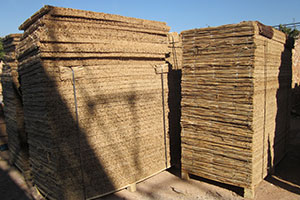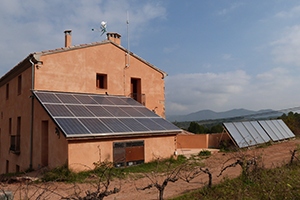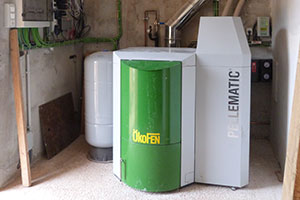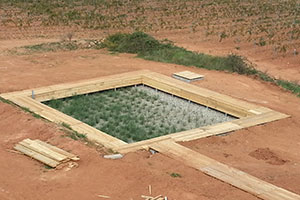Can Gramunt is the first completely refurbished building in Catalonia to achieve energy performance certificate A with zero emissions.
All hot water and heating is produced 100% by renewable energies and the building is independent of the electrical grid. The building was refurbished with natural and local building materials and there is a system for rainwater harvesting.



The building envelope
The first step towards a zero energy building is reducing the building’s energy demand, especially from energy losses through the building envelope. This is why the façades, floors and roof have been insulated a lot more than the current regulations require. The windows and doors have high quality glazing and frames, with elevated air tightness. In addition, natural and low impact materials have been used: the façade has been insulated with reed panels, the roof with blow-in cellulose and wood fibre panels. All windows and doors have larchwood frames. To prevent overheating in the summer, all south facing windows and doors are protected from solar radiation with larch laminate shutters, and the roof is ventilated.


Solar photovoltaic energy
The building is off grid and equipped with a stand-alone solar energy system. All electricity required by the apartments is produced by 30m2 of photovoltaic solar panels installed on the roof of what once was the space for the winepress. A battery bank stores energy and can provide the building with electricity for a few days without sunshine. All electrical appliances are rated A++ or higher, all lighting is LED lighting and all water pumps (for example in the swimming pool) are energy saving.


Solar thermal energy
All new built and entirely refurbished buildings in Catalonia are required to produce a large part of its domestic hot water with solar thermal energy. At Can Gramunt we have installed more than double the required solar thermal panels with the aim to additionally produce more than 50% of heating energy with solar energy. All holiday apartments are equipped with under-floor or under-wall heating to provide thermal comfort. These systems have many advantages, above all they enable a maximum use of solar energy as they work at low water temperatures (30-40ºC) due to the large surfaces they cover. These temperatures are easily produced by the solar panels, even in the winter.


Biomass
A biomass boiler supports the hot water system, as the solar energy cannot cover heating energy demand and in winter needs help with the domestic hot water. The boiler runs on wood pellets. This system allows us to produce all heat from 100% renewable energies, providing maximum comfort for our guests and also for ourselves, as the system works completely automatic. Thanks to the well insulted building envelope and water pipes we use very little fuel and produce hardly any emissions!


Building materials
Throughout the refurbishment special attention was paid to the use of natural building materials. The original structure was maintained where possible and the maximum possible amount of materials was reused: tiles and roof tiles, and all natural stones used to rebuild the second floor of the building were sourced from torn down walls on the property. The iron balcony balustrades have been recovered from a scrapyard, fixed and painted, and the balconies were designed to fit their width. All structural elements of the roof and the partition walls are timber structures and the insulation materials are reed panels, wood fibre panels or cellulose. The internal finishes are 100% natural, consisting in clay plaster made from clay sourced on the site, sand and water.


The water cycle
For health and safety reasons, drinking water is supplied by the mains, this being the only service that is not self-sufficient. In addition, rain water is harvested from the roofs and stored in tanks that have been restored on site: at the entrance, underneath the terrace of the Rosemary Apartment, and underneath the former winepress. The rainwater is used to flush the toilets and for watering the plants. The wastewater is treated in a natural reed wastewater treatment system close by, and purified water filtered into the ground.

